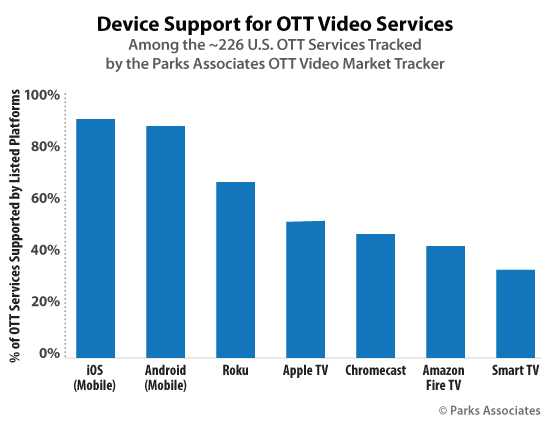OTT Platform Availability: Expectations vs. Reality
For any OTT service, including AVOD (advertising video on demand) players like Tubi TV or vMVPD offerings like Sling TV, platform availability is critical in both luring and retaining subscribers. Given the effort and cost required, services must pick and choose which platforms to support and the priority of development for those that will be supported. From a base set of platforms at launch, service providers continue to add device support as a service grows in order to reach new audiences and provide current subscribers with more ways to access content.
According to research published in Parks Associates OTT Video Market Tracker, mobile platforms are often prioritized for most services and are supported by 90% of US OTT video services. The iOS platform is closely controlled by Apple, providing services with a stable option that can be easily tested. Android is much more fragmented, but is seen as a necessary component given the number of Android smartphones used by consumers. Streaming media player is the next most commonly supported device category supported by US OTT video services. Roku is the leading platform in both market penetration among US households and support by OTT video services, and two-thirds of OTT services support Roku. Over half of OTT services support Apple TV with fewer supporting Chromecast and Fire TV, and smart TVs lag other device categories by a margin of more than 10%. Support for smart TVs is more challenging than support for other platforms due to the diversity of software platforms present among manufacturers. In addition, apps for these software platforms must be tested across multiple TV SKUs (or versions of the smart TV) to ensure that variations in the hardware and software will not result in an app that performs poorly or crashes.

While ease of development and testing impacts the devices supported, actual platform availability does not currently match consumer expectations. A late 2018 survey of broadband consumers tested service feature expectations for OTT video services offered at multiple price points. Interestingly, at all price points tested consumers expect OTT video services to support smart TVs more than any other device. Expectation of smart TV accessibility is twice as high as those for streaming media players such as Roku or Apple TV, and while smart phone support is available for 90% or more tracked OTT services, less than half of consumers actually expect that feature at any tested price point. The full results of this study are available in Parks Associates 360 Deep Dive: OTT Purchasing and Perceived Value.
The discrepancy between US consumer expectations and the reality of service availability is likely due to the frequency of consumer use of TV sets to consume internet video content – 52% in Q3 2018. Though these figures represent both smart TVs and streaming media player use, it explains why consumers would expect smart TV support more than smartphones, which are only used by a fifth of households for consuming movies and TV shows through the internet.
Though OTT penetration is at its highest level yet, consumer use of computers for OTT streaming has steadily declined over the years, and services are adding support for other devices to compensate for this shift in consumption behavior. Moving forward, as services increasingly offer support on new platforms and points of aggregation, it will be critical for services to be mindful of what consumers expect from their service in order to adapt their value proposition accordingly.
Further Reading:
- Average household spending on subscription OTT streaming services has held steady for the past three years
- Redefining Viewer Relationships: The New Approach in OTT
- Future of Video: OTT, Pay TV, and Digital Media
Next: Online Pay-TV Households More Dynamic in Their Subscription Behaviors
Previous: New Solution Revealed at CES Tackles Video Service Password Sharing
Comments
-
Be the first to leave a comment.
Post a Comment
Have a comment? Login or create an account to start a discussion.


